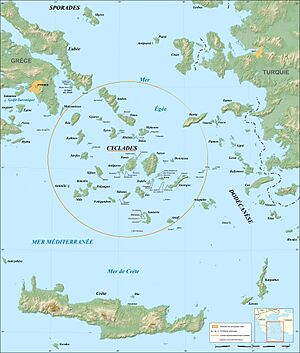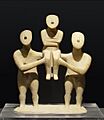Cycladic culture facts for kids
 |
|
| Period | Bronze Age |
|---|---|
| Dates | c. 3100–c. 1000 BC |
| Major sites | Grotta (Naxos), Phylakopi, Keros, Syros |
| Preceded by | Neolithic Greece |
| Followed by | Minoan civilization |
The Cycladic culture was an ancient civilization that existed during the Bronze Age (from about 3100 BC to 1000 BC). It was found on the islands of the Cyclades in the Aegean Sea. This culture is also known as the Cycladic civilization. It helps us date artifacts from that time, similar to how we date things from mainland Greece (Helladic chronology) and Crete (Minoan chronology) from the same period.
Contents
History of the Cycladic People
Life in the Late Neolithic Period
The Cycladic culture is famous for its unique marble figurines. These flat, simple statues usually show female figures, but sometimes male ones. We don't know their exact purpose. This culture grew at the same time as the Middle Bronze Age Minoan culture on Crete to the south.
Around 3000 BC, a special culture developed in the western Aegean Sea. It combined ideas from Anatolia (modern-day Turkey) and mainland Greece. People grew emmer wheat and barley. They also raised sheep, goats, and pigs. They even caught tuna from small boats. Important sites from this time include Chalandriani, Phylakopi, Skarkos, and Saliagos. Some sites, like Kephala on Kea, show that people were already working with copper.
The Early Bronze Age
The Early Cycladic culture developed in three main stages. This happened between about 3100 BC and 2300 BC. Finds at Knossos on Crete show that the Cycladic civilization influenced Knossos. This is clear from pottery found there from 3400 to 2000 BC.
The island of Kea has a Bronze Age settlement called Ayia Irini. It was most important during the Late Minoan and Early Mycenaean times (1600–1400 BC). The Mycenaean town of Naxos (around 1300 BC) was quite large. It stretched from today's city to the islet of "Palatia." Parts of it were found under a square in Chora, where the archaeological site of Grotta is now. Naxos has been lived in continuously for a very long time.
The Middle Bronze Age
During the Middle Bronze Age, the Cycladic culture spread out. Archaeologists have found artifacts and communities that show its influence grew. This included areas on the Greek mainland and Crete. Walls from this period suggest that older Cycladic settlements expanded.
Pottery is a key piece of evidence from this time. It helps us understand the period. Graves also provide important information. Changes in pottery styles have helped historians figure out more accurate dates for the Middle Cycladic period.
The Late Bronze Age
Each small Cycladic island could only support a few thousand people. However, models of Late Cycladic boats show they could gather crews of twenty-five rowers. When the powerful palace-culture of Crete grew, the Cycladic islands became less important. The Minoan culture from Crete began to have a stronger influence on the Cycladic islands.
Some islands, like Kea, Naxos, and Delos, were exceptions. Delos kept its ancient reputation as a special sanctuary. This lasted even into the time of Classical Greek civilization.
Understanding Cycladic Time Periods
Historians divide the Cycladic civilization into three main time periods. These are the Early, Middle, and Late Cycladic periods. The early period started around 3100 BC. It then moved into the Middle Cycladic period around 2000 BC. By the end of the Late Cycladic period (around 1000 BC), the Cycladic and Minoan cultures had become very similar.
There are different ways to date Cycladic civilization. One way uses "cultural" changes, and another uses "chronological" dates. Scholars try to link these two systems. Here is a table showing one way to connect them, suggested by Oliver Dickinson:
| Cycladic chronology | |||||||||||||
|---|---|---|---|---|---|---|---|---|---|---|---|---|---|
| Phase | Date | Culture | Contemporary mainland culture |
||||||||||
| Early Cycladic I (ECI) | 3100-2900 BC | Grotta-Pelos | Talioti and Eutresis | ||||||||||
| Early Cycladic II (ECII) | 2700-2200 BC | Keros-Syros culture | Lerna III | ||||||||||
| Early Cycladic III (ECIII) | 2450-2300 BC | Kastri | Lefkandi I | ||||||||||
| Middle Cycladic I (MCI) | 2000-1800 BC | Phylakopi | * | ||||||||||
| Middle Cycladic II (MCII) | 1800-1650 BC | * | * | ||||||||||
| Middle Cycladic III (MCIII) | 1650-1600 BC | * | * | ||||||||||
| Late Cycladic I | 1600-1500 BC | * | * | ||||||||||
| Late Cycladic II | 1500-1350 BC | * | * | ||||||||||
| Late Cycladic II | 1350-1000 BC | * | Submycenaean | ||||||||||
* Indicates this space is left intentionally blank due to lack of scholarly data.
Archaeological Discoveries

Archaeological digs started in the 1880s by people like Theodore Bent. Later, the British School at Athens and Christos Tsountas did more organized work. Tsountas explored burial sites in 1898–99 and was the first to use the name "Cycladic civilization."
Interest in the culture slowed down for a while. But it picked up again in the mid-20th century. This was partly because collectors wanted to own artifacts from Early Cycladic cemeteries.
The Importance of Pottery
Pottery makes up a large number of the artifacts we have from the Cycladic culture. It has been very important for dividing Cycladic history into different periods. This is because the style and materials of pottery changed over time.
Pottery was also very important for the Cycladic people's sea activities. Evidence suggests that pottery was a main item traded by boats. This was especially true during the Early Cycladic period.
Proof of Seafaring
We haven't found any complete boats from this time. However, other archaeological finds show that the Cycladic culture had rich seafaring practices. One type of find is the Cycladic "frying pans." We don't know their exact original use.
Despite this mystery, these frying pans give us clues about Cycladic culture through their pictures. The pan shown in this section, and others found by archaeologists, show ships. This tells us how important seafaring was to the Cycladic people. It also gives us an idea of how their ships were built. There were likely two types of ships: small boats for one or a few people, and longboats that could carry a crew of at least twenty-five.
Artifacts and Challenges
Studies of Cycladic culture have faced big challenges because of how artifacts were found. Since the early 1900s, private collectors have wanted Cycladic figures and other items. This led to many of these items being taken from their original places without permission. These figures were often taken from ancient burial sites.
This problem grew as collectors wanted these modern-looking figures. They seemed similar to sculptures by famous artists like Jean Arp or Constantin Brâncuși. As a result, many sites were disturbed, and fake items also appeared. Because of this, we often don't know the original setting for many Cycladic figurines. This means their true meaning might never be fully understood. It's thought that about 90% of the figures we know about were taken from their original spots without proper study. This has caused a loss of important information needed to understand their history.
Between 2009 and 2010, experts met with a person they called "the forger." This person gave them inside information about how artifacts and fakes were sold to collectors. They also learned how these fakes were made. This has helped archaeologists and scholars to identify fake items more accurately. It has also helped them trace some real artifacts back to where they originally came from.
See also
- Cycladic art
- Goulandris Museum of Cycladic Art
- History of the Cyclades
Images for kids
-
Marble seated harp player, 2800-2700 BC





